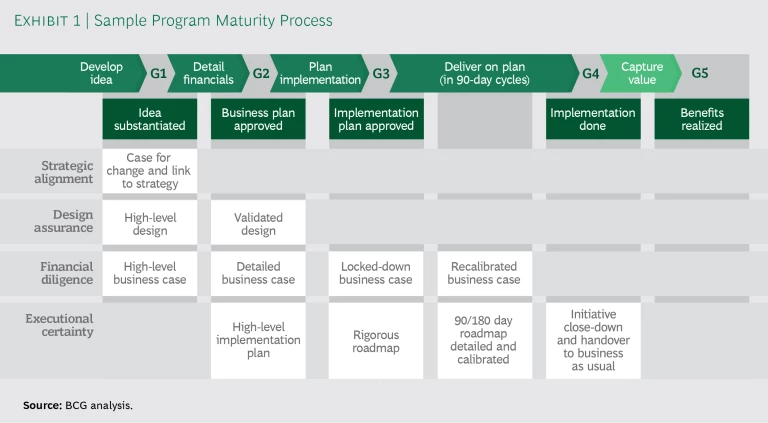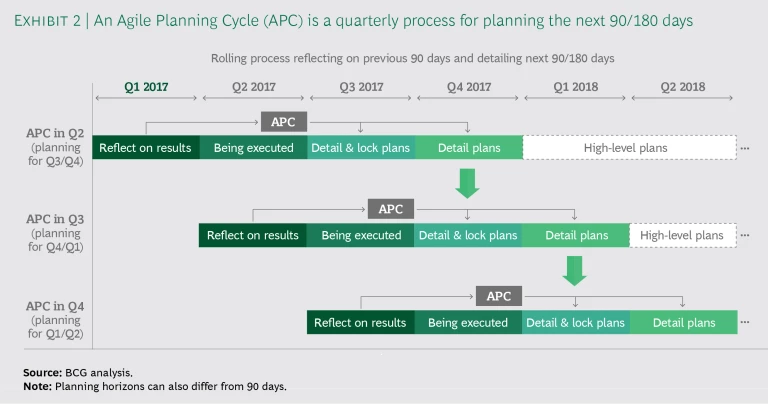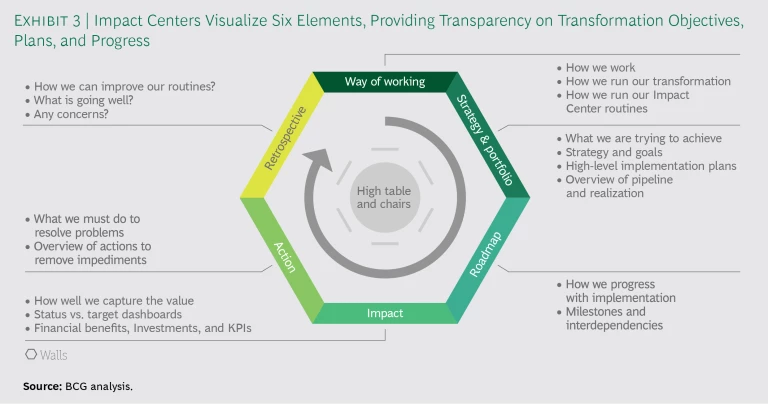Auto manufacturers are confronting self-driving cars and global banks are seeing their most attractive profit pools attacked by FinTechs. Traditional retailers have their businesses continuously upended by e-commerce, and companies in many other industries face once unimaginable forms of disruption. In such a tumultuous climate, transformation is imperative. Indeed, 52% of large public companies in Europe and North America announced they were undertaking transformation efforts in 2016—a 42% increase over 2006—while during the same period (2006–2016), 73% announced two rounds of transformation within two years.
Unfortunately, these transformations often fail to deliver the desired results. Many efforts are completed too late, short of specs, and against significantly higher costs than anticipated. According to BCG analysis, only 24% of companies experienced either short-term (one year) or long-term (five or more years) TSR growth greater than that of their industries after undergoing transformations.
We believe there are three root causes for the frequent failure of large change efforts to deliver on their promises:
- Lack of transparency in change portfolios leads to incoherent transformation efforts. Change portfolios can have a number of problems that, if undetected, will hinder the success of a transformation. A company may have more change programs than it is able to deliver on, or too many programs competing for the same scarce resources. It might have change programs that are not critical for executing the company’s strategy or, conversely, lack the programs needed to execute significant parts of the strategy. If senior leaders have incomplete visibility into their change portfolios, they may miss such problems and be unable to ensure the effectiveness of their transformation efforts.
- Traditional transformation management approaches force programs into long delivery cycles, and are unable to keep up with agile ways of working. Traditional program management approaches require multi-year detailed milestones and dependencies overviews—wholly inadequate in a world of non-stop, high-speed change and dynamic, agile teaming. This environment requires the targeted end-state of transformation efforts to shift repeatedly in the course of execution.
- Change leaders get disengaged and delegate key responsibilities. “Template-based,” “policing,” and other bureaucracy-driven change management approaches often encourage senior change leaders to hire a “program PMO lead,” to whom they delegate critical responsibilities. This person is made responsible for planning, alignment, and problem resolution, but often lacks a deep understanding of the change programs.
Our solution, an Agile Transformation Management approach, grew out of our work across industries and geographies. It is designed to tackle these root causes of historic under-delivery. Our approach offers a company’s change leaders visibility into the entire change portfolio, lending clarity and focus to planning while giving these leaders the flexibility to recalibrate their plans. At the same time, it enables and forces change leaders (and the overall company management) to take responsibility, to remain engaged and seek alignment with others by providing transparency on overall priorities, program plans, progress, impediments, removal of impediments, and other related actions.
The Elements of Agile Transformation Management
Agile Transformation Management has three key components.
1. Program Maturity Process
Senior leaders need the ability to track the status and maturity of individual programs, as well as the overall change portfolio. The Program Maturity Process is an always-on portfolio review that takes change initiatives from idea to benefit realization in a structured, disciplined way. It addresses three specific challenges that senior executives often face when managing traditional transformation approaches:
- Premature execution: Execution starts before objectives and plans are clear, and full buy-in is secured, leading to unnecessary course-correction later.
- Wasted efforts: Unclear change portfolio management allows individual executives or programs to invest scarce resources in non-priority initiatives and/or initiatives that will be terminated.
- Hasty closure: Success is celebrated and programs are closed before the promised benefits are fully and sustainably realized.
- Overreaching: A company tries to do everything and has too many programs, or uses one program as a vehicle for too many different objectives, leaving programs underresourced.
The Program Maturity Process is designed to ensure that all change programs perform well across four measures: strategic alignment, design assurance, financial diligence, and executional certainty. Strategic alignment involves securing the realization of your strategic goals. Design assurance means ensuring the best fit between solutions and program designs on the one hand, and existing companywide blueprints and operating models on the other. Financial diligence entails realizing clearly articulated business value with optimized investment and benefits profiles. And executional certainty means securing rigorous execution and value delivery. To achieve these four success measures, our process provides a clear and disciplined path through five maturity “gates.” Exhibit 1 illustrates these five gates:
The Program Maturity Process brings focus, clarity, and quality to the planning and execution of programs. On a company level, it ensures that an organization’s change resources are deployed in the places that count, and that the executive team has an always-on, end-to-end view of the company’s change portfolio, the related investment profile, and the intended benefits. This enables senior leaders to rebalance the change portfolio continuously in response to developments in change programs, the rest of the organization, and the outside world.
2. Agile Planning Cycle
The Agile Planning Cycle is a method for giving teams in the execution phase of the Program Maturity Process (between gates #3 and #4) the flexibility to frequently recalibrate their plans. Like the Program Maturity Process, it addresses some important challenges facing change leaders as they adapt traditional transformation management practices for today’s fast-changing world:
- Planning the unplannable: Detailed plans are typically required further ahead than feasible in a fast-changing environment.
- Adapting to changing conditions: Adapting plans to contextual changes is difficult due to infrequent (e.g., annual) and inflexible planning processes.
- Limited alignment: Transformation plans are often not fully aligned either horizontally or vertically, leading to unexpected problems and trade-offs during execution.
The Agile Planning Cycle aims, at the highest level, to facilitate two paradigm shifts in a company’s change management practice. The first shift is “from whales to dolphins,” changing the focus of programs from big-bang value delivery at the end to continual delivery of business value in smaller increments, ideally every 90 days. The second shift is “from fixed to flexible planning,” enabling programs to plan, execute, and reflect every quarter, and to incorporate related learning in their next quarter’s plan.
The Agile Planning Cycle is a 90-day process that plans for the next 180 days. Program leaders follow the steps below in each of their quarterly review sessions.
- Get guidance from the executive board on companywide strategic objectives and priorities.
- Write quarterly program reviews.
- Appraise the quarterly reviews of related programs and mutually align subsequent plans.
- Join a marketplace-like meeting to collectively resolve final alignment issues and sign off on collective 90/180 day plans.
- Send remaining alignment issues to the Executive Board for resolution.
The Agile Planning Cycle ensures that program plans are fully aligned—horizontally, with other programs, and vertically, with the strategic direction set by the executive board. Exhibit 2 illustrates how the 90/180 day cycle works.
3. Impact Center
After the detailed 90- and 180-day plans and milestones are finalized, they are visualized in an Impact Center for tracking progress and clearing away impediments. The Impact Center is a physical (obeya) room where teams undergo a set of disciplined routines. The process is designed to force change leaders to provide transparency on their plans, their progress, and the impediments they face—and empower them to do away with these impediments, then and there. Like both the Program Maturity Process and the Agile Planning Cycle, the Impact Center addresses specific challenges faced by change leaders adapting traditional transformation management practices in today’s environment:
- Disengaged change community: “Templated” and PMO-driven transformation management causes change leaders and teams to disengage.
- Tracking time sink: Tracking progress is bureaucratic and time-consuming; exercises such as traffic light reports are discussed endlessly without leading to action.
- Slow problem resolution: Clearing away impediments is often slow, since decisions are passed on from layer to layer or silo to silo.
- Solutions in silos: Solutions to impediments are often sub-optimal, because key experts and stakeholders are not involved in decision-making.
Three important principles should guide the development of an Impact Center and its rhythms and routines: meaningful interaction (through, for example, visualization of milestones, intended impacts, and impediments to trigger needed discussion) rather than reports; a full focus on removing impediments instead of on reviewing general progress reports; and a mandate for program leads and specialists to engage in collaborative decision-making to remove impediments rather than dodge their responsibility to assist others.
An Impact Center is set up to create visualizations of six elements, providing transparency on transformation objectives, plans, progress, impediments, and actions for removing impediments:
The “walls” depicted above can be either literal or figurative. More important than the physical configuration of the Impact Center are the routines that take place there—typically monthly, although in fast-paced transformations we’ve seen weekly and, in distressed situations, even daily cycles. Although these routines must be tailored to a specific company’s organization and governance models, we typically facilitate three types of meetings in an Impact Center:
- A Program Leaders meeting (in Week 1 of each month, for example), concentrates on the Roadmap Wall and focuses on identifying all impediments that change teams face in their daily work and can’t remove themselves. Program leaders should use this time to identify one or more actions for removing these impediments. If it proves impossible to identify actions to address any particular impediment, the problem is automatically put on the agenda for the next session, the Program Owners meeting.
- A Program Owners meeting (in Week 2 of each month, for example), is attended by all senior line managers responsible for creating business value. This meeting typically concentrates on the Performance Wall and focuses on dealing with impediments that Program Leaders have been unable to remove. The goal is to ensure the program deliverables are able to realize their intended business value. If there are impediments that Program Owners cannot remove, these are brought to the Executive Board.
- An Executive Board meeting (in Week 3 of each month, for example), typically concentrates on the Strategy & Portfolio Wall and focuses on clearing away impediments brought to the meeting for resolution by the Program Owners. The aim is to ascertain whether the full change portfolio is on track to deliver on the company’s strategic objectives.
The Action Wall, which broadcasts all actions taken to remove impediments to the progress of the transformation, is often the true game changer in Agile Transformation Management. It offers no place to hide for any of the company’s change leaders—dramatically increasing the responsiveness, most notably, of the senior executives, who all too often avoid pressing operational issues that need their attention.
A Program Maturity Process provides visibility into the entire transformation, an Agile Planning Cycle provides the necessary flexibility, and an Impact Center ensures that everyone involved in leading change—all the way up to senior management—takes responsibility for its success. Together, these elements of Agile Transformation Management enable companies to tackle the root causes of under-delivery in transformation efforts. By giving change leaders the autonomy to move quickly while securing alignment across programs—and alignment of these programs with company strategy—Agile Transformation Management enables companies to realize the true promise and potential of corporate transformation, even in a world of constant and dizzying change.








